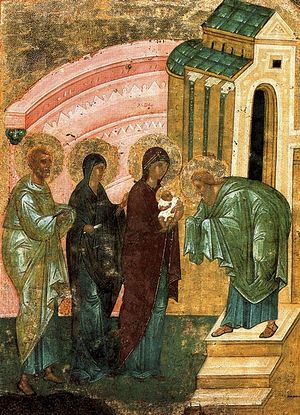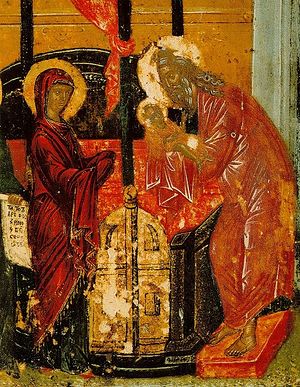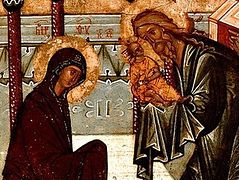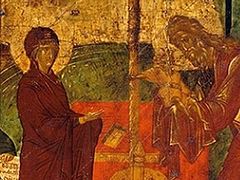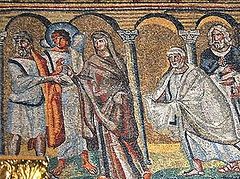What is the Spiritual Meaning of the Feast of the Meeting of the Lord? Why did the meeting of Elder Simeon with the Infant Jesus become a great Christian feast day? Hieromonk Job (Gumerov) talks about today’s feast.
The event that initiated this one of the twelve great feasts is, in the spiritual sense, multi-dimensional. The word “meeting” does not convey the main significance of the Church Slavonic understanding of sretenie. Ordinarily those who meet are equals. “But here,” as Metropolitan Benjamin (Fedchenkov) notes, “the Slavonic word, sretenie, is more fitting, for it speaks of the coming out of the lesser to meet the greater; of people coming to meet God” (Letters on the Twelve Great Feasts [Moscow, 2004], 170-1 [Russian]). The event in the Jerusalem temple has particular significance. The Divine Law-Giver Himself, as the firstborn of every creature (Col. 1:15) and as the firstborn of the Virgin (Mt. 1:25) is brought as a gift to God. This symbolic act is as if the beginning of that service, which would end on earth with a great event: the incarnate Son of God would offer His whole self to God for the redemption of mankind, with whom he had earlier met in the person of righteous Simeon. For mine eyes have seen thy salvation, which thou hast prepared before the face of all people; a light to lighten the Gentiles, and the glory of thy people Israel (Lk. 2:30-32). This song of thanksgiving goes back in thought and expression to certain passages in the book of the Prophet Isaiah: And in that day there shall be a root of Jesse, and he that shall arise to rule over the Gentiles; in him shall the Gentiles trust, and his rest shall be glorious (Is. 11:10). Jesse was the father of King David. Therefore, the Root of Jesse—the people’s awaited Messiah Christ, the Son of David (cf. Mt. 1:1), Who, as two centuries of history shows, will become a a sign which shall be spoken against. This sign will divide people into the believing and the unbelieving, into those who love the light and those who choose darkness. “What is this sign which shall be spoken against? It is the Sign of the Cross, which the Church will confess as salvific for the whole world” (St. John Chrysostom).
The meeting of God and man, which first took place in the Jerusalem temple, must become for each of us a personal event. Our path of salvation must begin by a meeting with Jesus Christ as our personal Savior. Until this meeting takes place, we remain sitting in darkness… and in the shadow of death (Mt. 4:16).
On the fortieth day after the Birth of the Infant God, yet another meeting took place—the Old Testament Church and the New Testament Church. The entire Gospel passage is penetrated with the motif of exact fulfillment of the law of Moses: the forty-day period of purification prescribed in the book of Leviticus (cf. 12:2-4), the dedication of the firstborn son to God (cf. Num. 3:13), and that firstborn son’s symbolic redemption (Ex. 13:13). Nevertheless, it is easy to see that the spiritual center of the event described is completely transferred into New Testament history. Now (Lk. 2:29) means that the time awaited by many generations of the coming of the Messiah has arrived. Holy righteous Simeon speaks of the departure from this world (the verb depart in the Greek and Slavonic texts is in the present tense). The elder Simeon’s inspired speech is filled with praise and thanksgiving to God that the time of promise is now fulfilled. According to patristic tradition, the holy Prophet Zacharias, father of St. John the Baptist, placed the Holy Virgin who came according to the law to fulfill the rite not in the place designated for women there for purification, but in the place designated for virgins (women who had husbands were not allowed to stand there). And when the scribes and Pharisees expressed their indignation, Zacharias proclaimed that this Mother remains and will remain a Virgin and pure: “Therefore I have not forbidden this Mother to stand in the place appointed for virgins, because She is higher than all virgins.”
The third meeting is of an extremely personal character. For the elder Simeon, the day has come for which he had waited an unusually long time. He was promised to see the Savior of the world, born of the Most Pure Virgin Mary. Righteous Simeon, distinguished by his brilliant learnedness, as a wise man who knew the Divine Scripture very well, labored together with seventy-two translators on the island of Pharos in Alexandria in the 380’s B.C. over the translation of the books of the Old Testament from Hebrew into Greek. While translating the book of the Prophet Isaiah, he came to the words, Behold, a virgin shall conceive in the womb, and shall bring forth a son (Is. 7:14). When he read this, he doubted, thinking that it was impossible for a woman to give birth without a husband. Simeon took a knife and wanted to erase these words from the scroll and replace “virgin” with “woman”. But then an angel of the Lord appeared to him stayed his hand, saying, “Have faith in the words written, and you yourself will behold their fulfillment, for you shall not see death until you have seen the Lord Christ born of a virgin.” Believing the angels words, the elder Simeon waited impatiently for Christ’s coming into the world, and led a righteous and blameless life. According to tradition, elder Simeon was vouchsafed a blessed end in the 360th year of his life. His holy relics were translated during the reign of Emperor Justinian the Younger (565-578) to Constantinople and placed in the chapel of the Apostle Jacob of the Chalkoprateia church.
The prayer of St. Simeon the God-Receiver (now lettest Thou Thy servant depart, O Master) is sung (on feast days) or read (during simple services) every evening, so that the passing day would remind every believer of the sunset of his life, which ends with his departure from this temporary life. We must live our lives in peace with God and fulfillment of the Gospel commandments, so that like the holy elder Simeon, we might joyfully greet the endless and bright day in the Kingdom of Heaven.

